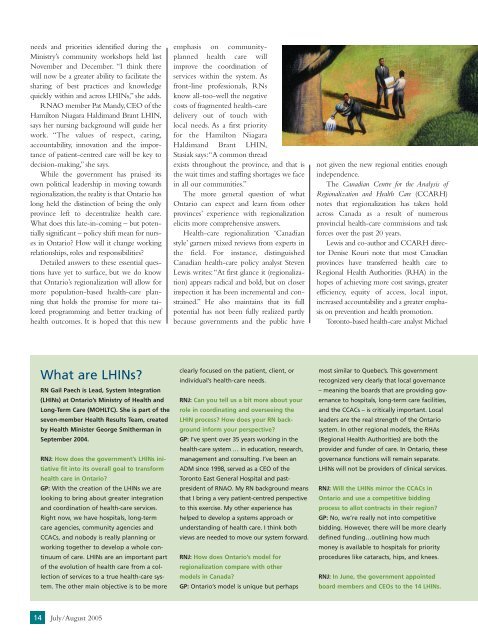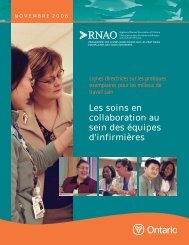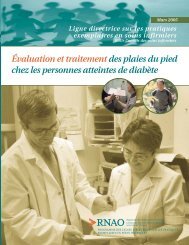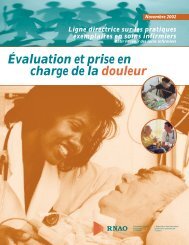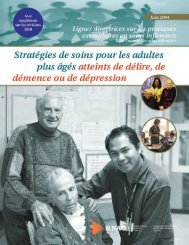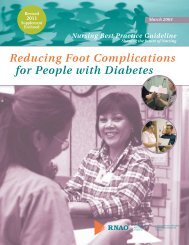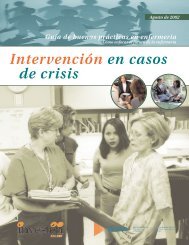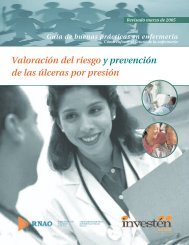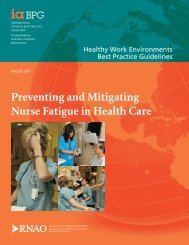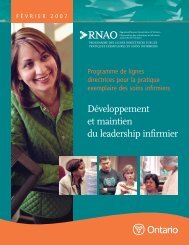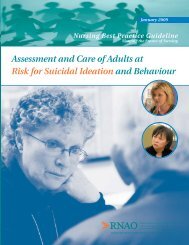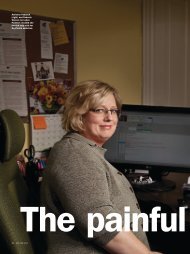lhins: bringing it all back home - Registered Nurses' Association of ...
lhins: bringing it all back home - Registered Nurses' Association of ...
lhins: bringing it all back home - Registered Nurses' Association of ...
Create successful ePaper yourself
Turn your PDF publications into a flip-book with our unique Google optimized e-Paper software.
needs and prior<strong>it</strong>ies identified during the<br />
Ministry’s commun<strong>it</strong>y workshops held last<br />
November and December. “I think there<br />
will now be a greater abil<strong>it</strong>y to facil<strong>it</strong>ate the<br />
sharing <strong>of</strong> best practices and knowledge<br />
quickly w<strong>it</strong>hin and across LHINs,” she adds.<br />
RNAO member Pat Mandy, CEO <strong>of</strong> the<br />
Hamilton Niagara Haldimand Brant LHIN,<br />
says her nursing <strong>back</strong>ground will guide her<br />
work. “The values <strong>of</strong> respect, caring,<br />
accountabil<strong>it</strong>y, innovation and the importance<br />
<strong>of</strong> patient-centred care will be key to<br />
decision-making,” she says.<br />
While the government has praised <strong>it</strong>s<br />
own pol<strong>it</strong>ical leadership in moving towards<br />
regionalization,the real<strong>it</strong>y is that Ontario has<br />
long held the distinction <strong>of</strong> being the only<br />
province left to decentralize health care.<br />
What does this late-in-coming – but potenti<strong>all</strong>y<br />
significant – policy shift mean for nurses<br />
in Ontario? How will <strong>it</strong> change working<br />
relationships, roles and responsibil<strong>it</strong>ies?<br />
Detailed answers to these essential questions<br />
have yet to surface, but we do know<br />
that Ontario’s regionalization will <strong>all</strong>ow for<br />
more population-based health-care planning<br />
that holds the promise for more tailored<br />
programming and better tracking <strong>of</strong><br />
health outcomes. It is hoped that this new<br />
What are LHINs?<br />
RN Gail Paech is Lead, System Integration<br />
(LHINs) at Ontario’s Ministry <strong>of</strong> Health and<br />
Long-Term Care (MOHLTC). She is part <strong>of</strong> the<br />
seven-member Health Results Team, created<br />
by Health Minister George Sm<strong>it</strong>herman in<br />
September 2004.<br />
RNJ: How does the government’s LHINs in<strong>it</strong>iative<br />
f<strong>it</strong> into <strong>it</strong>s over<strong>all</strong> goal to transform<br />
health care in Ontario?<br />
GP: W<strong>it</strong>h the creation <strong>of</strong> the LHINs we are<br />
looking to bring about greater integration<br />
and coordination <strong>of</strong> health-care services.<br />
Right now, we have hosp<strong>it</strong>als, long-term<br />
care agencies, commun<strong>it</strong>y agencies and<br />
CCACs, and nobody is re<strong>all</strong>y planning or<br />
working together to develop a whole continuum<br />
<strong>of</strong> care. LHINs are an important part<br />
<strong>of</strong> the evolution <strong>of</strong> health care from a collection<br />
<strong>of</strong> services to a true health-care system.<br />
The other main objective is to be more<br />
14 July/August 2005<br />
emphasis on commun<strong>it</strong>yplanned<br />
health care will<br />
improve the coordination <strong>of</strong><br />
services w<strong>it</strong>hin the system. As<br />
front-line pr<strong>of</strong>essionals, RNs<br />
know <strong>all</strong>-too-well the negative<br />
costs <strong>of</strong> fragmented health-care<br />
delivery out <strong>of</strong> touch w<strong>it</strong>h<br />
local needs. As a first prior<strong>it</strong>y<br />
for the Hamilton Niagara<br />
Haldimand Brant LHIN,<br />
Stasiak says:“A common thread<br />
exists throughout the province, and that is<br />
the wa<strong>it</strong> times and staffing shortages we face<br />
in <strong>all</strong> our commun<strong>it</strong>ies.”<br />
The more general question <strong>of</strong> what<br />
Ontario can expect and learn from other<br />
provinces’ experience w<strong>it</strong>h regionalization<br />
elic<strong>it</strong>s more comprehensive answers.<br />
Health-care regionalization ‘Canadian<br />
style’ garners mixed reviews from experts in<br />
the field. For instance, distinguished<br />
Canadian health-care policy analyst Steven<br />
Lewis wr<strong>it</strong>es:“At first glance <strong>it</strong> (regionalization)<br />
appears radical and bold, but on closer<br />
inspection <strong>it</strong> has been incremental and constrained.”<br />
He also maintains that <strong>it</strong>s full<br />
potential has not been fully realized partly<br />
because governments and the public have<br />
clearly focused on the patient, client, or<br />
individual’s health-care needs.<br />
RNJ: Can you tell us a b<strong>it</strong> more about your<br />
role in coordinating and overseeing the<br />
LHIN process? How does your RN <strong>back</strong>ground<br />
inform your perspective?<br />
GP: I’ve spent over 35 years working in the<br />
health-care system … in education, research,<br />
management and consulting. I’ve been an<br />
ADM since 1998, served as a CEO <strong>of</strong> the<br />
Toronto East General Hosp<strong>it</strong>al and pastpresident<br />
<strong>of</strong> RNAO. My RN <strong>back</strong>ground means<br />
that I bring a very patient-centred perspective<br />
to this exercise. My other experience has<br />
helped to develop a systems approach or<br />
understanding <strong>of</strong> health care. I think both<br />
views are needed to move our system forward.<br />
RNJ: How does Ontario’s model for<br />
regionalization compare w<strong>it</strong>h other<br />
models in Canada?<br />
GP: Ontario’s model is unique but perhaps<br />
not given the new regional ent<strong>it</strong>ies enough<br />
independence.<br />
The Canadian Centre for the Analysis <strong>of</strong><br />
Regionalization and Health Care (CCARH)<br />
notes that regionalization has taken hold<br />
across Canada as a result <strong>of</strong> numerous<br />
provincial health-care commissions and task<br />
forces over the past 20 years.<br />
Lewis and co-author and CCARH director<br />
Denise Kouri note that most Canadian<br />
provinces have transferred health care to<br />
Regional Health Author<strong>it</strong>ies (RHA) in the<br />
hopes <strong>of</strong> achieving more cost savings, greater<br />
efficiency, equ<strong>it</strong>y <strong>of</strong> access, local input,<br />
increased accountabil<strong>it</strong>y and a greater emphasis<br />
on prevention and health promotion.<br />
Toronto-based health-care analyst Michael<br />
most similar to Quebec’s. This government<br />
recognized very clearly that local governance<br />
– meaning the boards that are providing governance<br />
to hosp<strong>it</strong>als, long-term care facil<strong>it</strong>ies,<br />
and the CCACs – is cr<strong>it</strong>ic<strong>all</strong>y important. Local<br />
leaders are the real strength <strong>of</strong> the Ontario<br />
system. In other regional models, the RHAs<br />
(Regional Health Author<strong>it</strong>ies) are both the<br />
provider and funder <strong>of</strong> care. In Ontario, these<br />
governance functions will remain separate.<br />
LHINs will not be providers <strong>of</strong> clinical services.<br />
RNJ: Will the LHINs mirror the CCACs in<br />
Ontario and use a compet<strong>it</strong>ive bidding<br />
process to <strong>all</strong>ot contracts in their region?<br />
GP: No, we’re re<strong>all</strong>y not into compet<strong>it</strong>ive<br />
bidding. However, there will be more clearly<br />
defined funding…outlining how much<br />
money is available to hosp<strong>it</strong>als for prior<strong>it</strong>y<br />
procedures like cataracts, hips, and knees.<br />
RNJ: In June, the government appointed<br />
board members and CEOs to the 14 LHINs.


